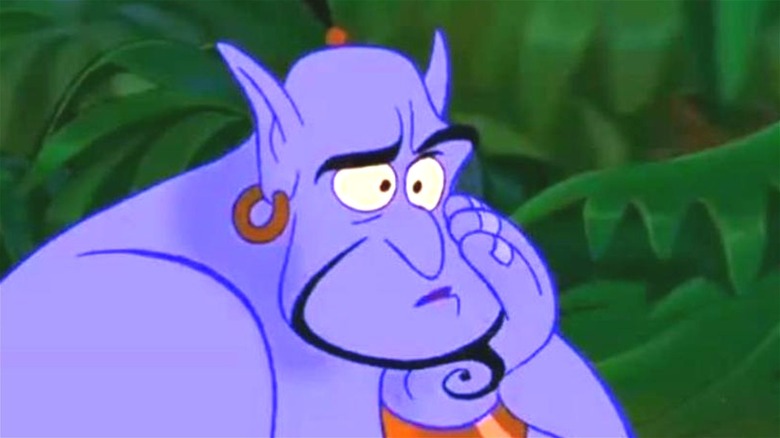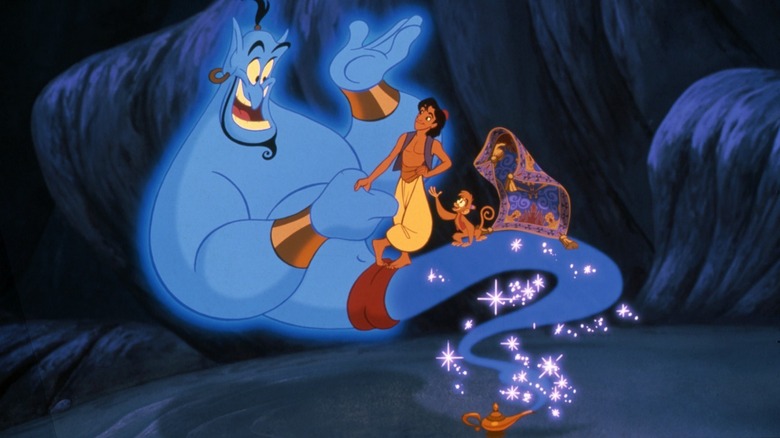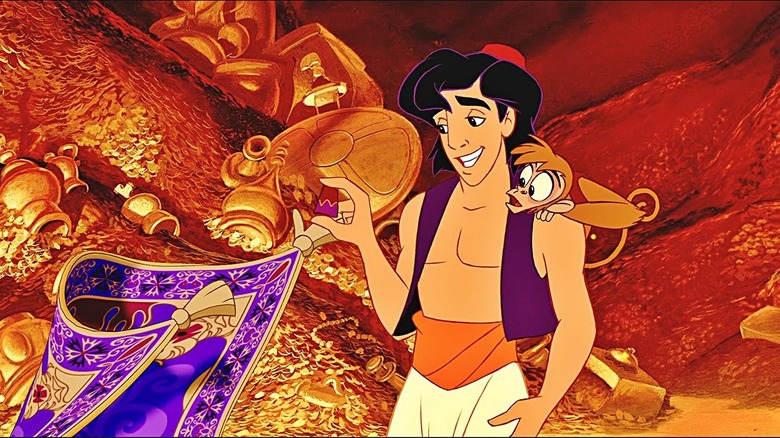Disney's Classic Aladdin Was Almost A Very Different Movie
An evil wizard, a lonely princess, a thief whose kind heart made him a diamond in the proverbial rough, and giant, blue, genie — these are the basic ingredients to one of the most beloved animated classics from Disney's Golden Age: "Aladdin." At this point, to have lived is to have seen the 1992 animated feature, a film so synonymous with Disney that it's a wonder Robin Williams' Genie never became the company's official mascot.
"Aladdin" spawned multiple direct-to-home-video sequels. There were video games, a TV series that was a part of the fabled Disney Afternoon lineup and, yes, even a live-action remake starring the Fresh Prince himself Will Smith in the Genie role. However, in the "Loki" multiverse sense of the word, things could have gone a very different way. These things are not uncommon. Stories evolve over time. The original conclusion for "Lilo and Stitch" had to be changed because of the tragedies on September 11, 2001, for example. In the case of "Aladdin," however, even the initial pitch was radically unlike the final product we saw.
It was Howard Ashman (whose work on "The Little Mermaid" with Alan Menken is equally iconic within the Disney canon) who first had an "Aladdin" story in mind — one that hewed closer to the original tale. What exactly did Ashman pitch for "Aladdin"? And why did we get the story we ultimately did instead? Thanks to the Disney Vaults, we know the story behind a whole new world we almost saw.
A very different Genie
Howard Ashman didn't just put together a small pitch for "Aladdin," he really threw everything he had at the potential project. There was a 40-page treatment. There were character descriptions. He'd penned no less than seven songs. He had a singular vision for what he wanted: "Aladdin" wasn't going to be a love song between a thief and a princess; it was going to be kind of buddy story in the vein of the 1940s Bob Hope and Bing Crosby variety.
The entire "Aladdin" affair was meant to be something altogether jazzier, with influences like the Andrews Sisters and a genie inspired not by Robin Williams, but by Cab Calloway. In fact, the song "Friend Like Me" was originally meant to ape Calloway's style.
Ashman loved the original story that "Aladdin" is based on, "One Thousand and One Nights," so he wanted to craft an animated version more faithful to that classic tale. It wasn't just the music and the genie that would have been different — virtually every character and every narrative beat would have been totally different. In fact, there are a number of characters in Ashman's pitch who don't appear in the final version at all.
Aladdin nearly had something almost no Disney hero does
Ashman envisioned an Aladdin tricked by an evil wizard into going into a sacred cave to obtain the genie of the lamp. Not only does Aladdin succeed, but he also comes out of that cave with the Genie of the Ring — that's right, we're talking about two genies for the price of one. The Genie of the Lamp grants the wishes Aladdin needs to get in good with the sultan, but it's the Genie of the Ring who saves Aladdin's bacon after the evil wizard makes off with the Genie of the Lamp.
Imagine, if you will, an Aladdin not friends with a small monkey named Abu, but one with multiple, human allies. Not only that, but Ashman envisioned the story as a family affair. Unlike so many Disney protagonists, Aladdin was going to have a mother. In fact, Aladdin's mother would act as his core inspiration — he just wants to make her proud. As a result, the story becomes less about the accumulation of power and wealth on a quest to win the heart of Princess Jasmine, and more about rejecting materialism and living a quiet, honest life.
As a matter of fact, Jasmine is not even the woman Aladdin winds up with in Ashman's treatment. Jasmine is designed more after Betty Boop, someone who is spoiled rotten and likes it that way. She was even going to sing a song about it. Instead, Aladdin was meant to wind up with a tomboy character named Abbi. The supporting characters are so different that even Gilbert Gottfried's Iago was originally a completely different kind of parrot named Sinbad.
Eventually, co-directors from "The Little Mermaid" — Ron Clements and John Musker — were brought on board to tweak Ashman's ideas. They took what they liked from Ashman's work and the rest, as they say, is history.


